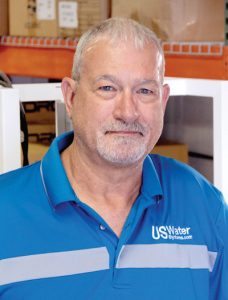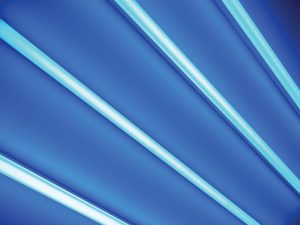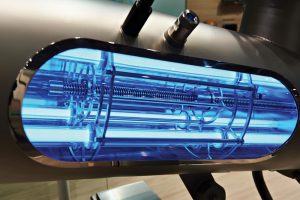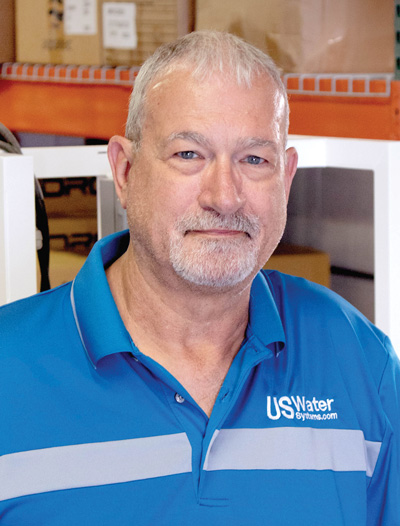— By Mark Timmons —
The 101 on UV-C lighting.
Fall and winter present a new challenge in restaurant and facility management with the continuing COVID-19 pandemic impacting businesses around the world and now it’s flu season. Taking a look back, several months ago, in-person dining felt like an overwhelming hurdle. Reopening a retail business seemed daunting. Yet we did it.

Mark Timmons, US Water Systems
As we turn to stabilizing business, in some parts of the United States al fresco dining is done. It’s simply too cold outside for outdoor dining. With the holiday season coming up fast if retailers haven’t figured out how to keep shoppers safe, now is the time to examine protocols and bridge any gaps.
Perhaps over the last year you stepped up your cleaning protocols, maybe you improved your HVAC systems, and perhaps you reorganized and reconfigured your dining tables. And let’s not forget those 6-feet-apart markers carefully placed at checkouts. It’s a lot to keep thinking about. But it’s important for leaders making critical decisions about health and safety to learn about every option available, including UV-C lighting systems.
These systems have been used for decades and recent studies show they are proven to deactivate the virus that causes COVID-19. UV-C use is not new. It has been used to disinfect water for over 100 years. Systems have been effectively used in hospitals for decades. Recent national articles report cruise lines are considering installation on ships, airlines are using it on planes and more businesses than ever before are showing interest.
Speaking from experience, this year our company has sold systems to a variety of businesses from across the country including a sizable metropolitan police department, churches, fitness facilities, manufacturers, schools and healthcare organizations. Here are the basics on UV-C systems:
How do they work?
A recent NPR article about UV-C systems combating the COVID-19 virus said, “Think of it like giving the virus a lethal sunburn.” A great comparison. UV-C uses a part of the electromagnetic spectrum that has short waves of radiant energy: the UV-C.
 The first full-scale ultraviolet disinfection systems were developed in France in 1908. UV has proven to be the gold standard for disinfection in water for over 100 years. Today this method is commonly used to clear germs from public water supplies. It requires a much higher dose of UV (more watts) than what’s used for disinfecting the air.
The first full-scale ultraviolet disinfection systems were developed in France in 1908. UV has proven to be the gold standard for disinfection in water for over 100 years. Today this method is commonly used to clear germs from public water supplies. It requires a much higher dose of UV (more watts) than what’s used for disinfecting the air.
UV-C light doesn’t kill microorganisms. Instead it is very effective at deactivating them and preventing them from replicating into more colonies. Keep in mind the only thing that microorganisms do in life is replicate and make colonies, which is why people get sick if they consume bacteria in large amounts of drinking water or come in contact with it via the air or surfaces.
Is there proof UV-C works?
Yes. There have been several studies showing these systems are safe, reliable and proven to eliminate bacteria and viruses. This year studies have focused on the virus that causes COVID-19 and have shown effective deactivation.
 A June 2020 study from Boston University proves the UV-C lighting effectively deactivates the virus that causes COVID-19. The BU National Emerging Infectious Diseases Laboratories (NEIDL) exposed materials containing the SARS-CoV-2 virus to a UV-C tube lamp from Signify. It found that a dose of 5 mJ/cm2 resulted in “a reduction of the SARS-CoV-2 virus of 99% in 6 seconds.”
A June 2020 study from Boston University proves the UV-C lighting effectively deactivates the virus that causes COVID-19. The BU National Emerging Infectious Diseases Laboratories (NEIDL) exposed materials containing the SARS-CoV-2 virus to a UV-C tube lamp from Signify. It found that a dose of 5 mJ/cm2 resulted in “a reduction of the SARS-CoV-2 virus of 99% in 6 seconds.”
SciTechDaily published a story in September 2020 about a study at Hiroshima University proving UV-C light is safe and kills the virus that causes COVID-19. An in vitro experiment by HU researchers showed that 99.7% of the SARS-CoV-2 viral culture was killed after a 30-second exposure to 222 nm UVC irradiation at 0.1 mW/cm2. The study is published in the American Journal of Infection Control.
How do I choose a system?
UV-C systems are manufactured for water, air and surface deactivation. Today’s systems are small and portable, but the technology must emit the right amount of light to be safe and effective. Consider the UV-C wavelength, dose and duration of exposure.
Air duct disinfection systems range in UV-C output from 6.2 to 42 watts. Criteria for choosing a system includes duct size, length, air speed and air temperature. These details allow a professional to calculate the right wattage for the space.
Portable air sanitizers likewise have a range of UV-C watt output. Dosage is a function of time and intensity to which the air and surrounding surfaces are exposed.
Bottom line, choosing a system can be compared to investing in a new HVAC system. Consult with a professional to be sure the right system for the right use and space are applied to keep staff, customers and others safe.
— Mark Timmons (The Water Doctor), co-owns and operates US Water Systems with his wife Patty who is the CEO. US Water Systems was founded in 2004 and is a certified Indiana WBE. Products manufactured and sold nationwide include UV-C surface, air and water systems along with water filtration solutions.

